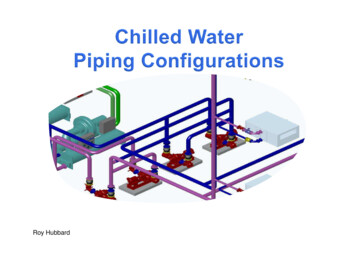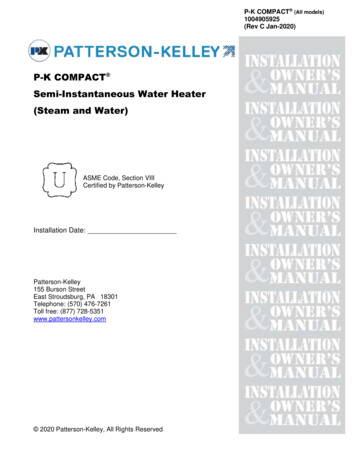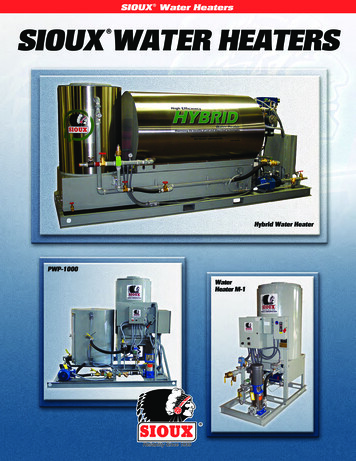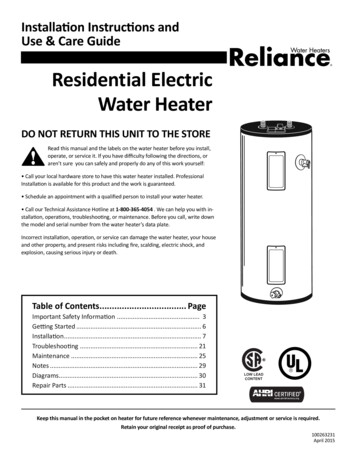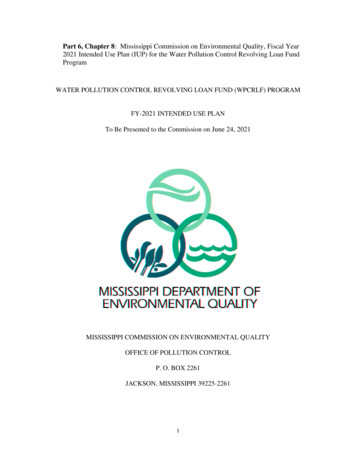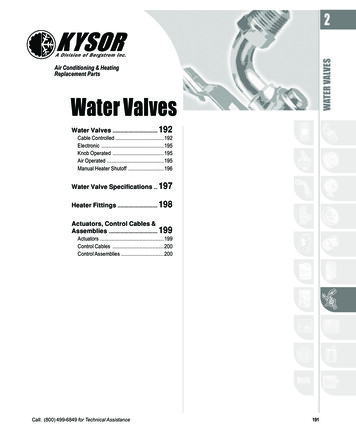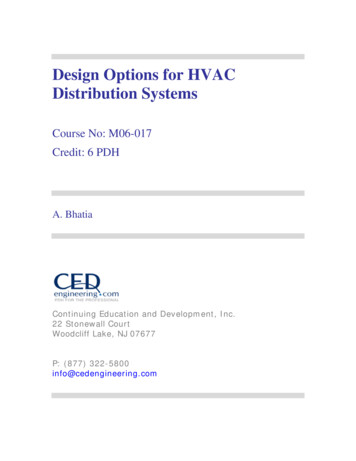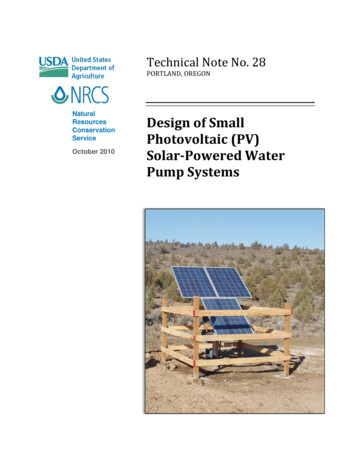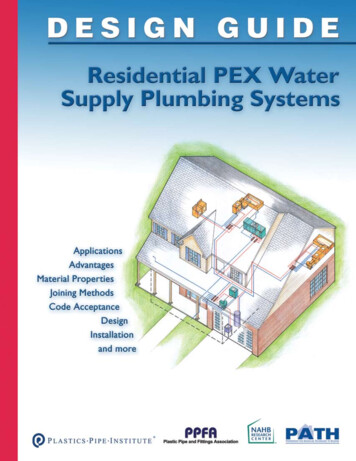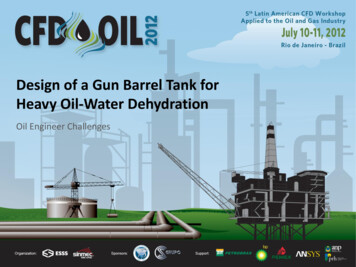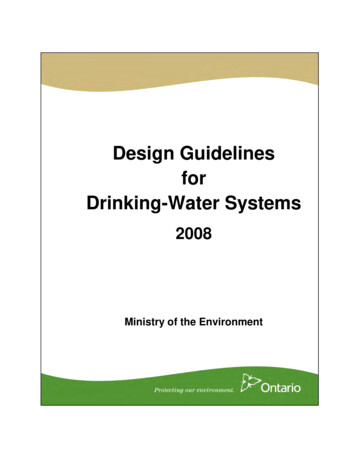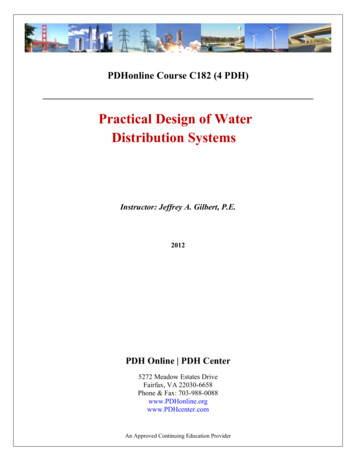
Transcription
PDHonline Course C182 (4 PDH)Practical Design of WaterDistribution SystemsInstructor: Jeffrey A. Gilbert, P.E.2012PDH Online PDH Center5272 Meadow Estates DriveFairfax, VA 22030-6658Phone & Fax: 703-988-0088www.PDHonline.orgwww.PDHcenter.comAn Approved Continuing Education Provider
www.PDHcenter.comPDH Course C182www.PDHonline.orgPractical Design of Water Distribution SystemsJeffrey A. Gilbert, P.E.Course .7MATERIALS3DEFINITIONSDUCTILE IRON PIPEPLASTIC PRESSURE PIPEPROTECTIONFITTINGSVALVESBOLTS, NUTS and TER DEMANDWATER DISTRIBUTION SYSTEMSWATER DISTRIBUTION MODELINGPUMPSVALVESTANKS AND RESERVOIRSCONTROLS AYING OUT A PROJECTEXISTING DATASCHEMATIC GENERALLYPRESSURE ZONESCOMPILED DATABUILDING THE MODELTROUBLESHOOTING A MODELFINAL NOTES4.0SUMMARY5.0RELATED LINKS21222223232426272728Page 1 of 28
www.PDHcenter.com1.0MATERIALS1.1DEFINITIONSPDH Course C182www.PDHonline.orgDuctile Iron Pipe (DIP)- Pipe which is manufactured from ferrous material in which amajor portion contains carbon occurring as a free graphite in substantially nodular orspheroidal form. (Reference: ANSI/AWWA C110/A21.10).ANSI-American National Standards InstituteAWWA-American Water Works AssociationFlanged Joint- A pipe joint that has a flared flange made into the pipe end to receivebolts to couple an adjoining flanged pipe or fitting.Gray Iron Pipe- Pipe which is manufactured from ferrous material in which a majorportion contains carbon occurring in the form of flakes interspersed throughout the metal.Mechanical Joints- Mechanical joints are pipe joints that are gasketed and boltedtogether. See ANSI/AWWA C111/A21.11.Push on Pipe Joints- Single rubber gasket pipe joints where the pipe sections are pushedtogether and not restrained. See ANSI/AWWA C111/A21.11.1.2DUCTILE IRON PIPEANSI/AWWA C110/A21.10.DIP from 3” to 24” with mechanical joints or push-on joints is pressure rated for 350 psi.DIP with flanged joints is rated for 250 psi except that sizes 12” and smaller with specialgaskets can be rated for 350 psi. Gray iron fittings for this standard are rated at 150 psi or250 psi for all joints. See Table below.DIP 30” to 64” pressure class 150 to 350DIP Outside coatings to be petroleum asphaltic, 1 mil thick. This material adheres to rawDIP and does not become brittle in any condition, buried or exposed.Page 2 of 28
www.PDHcenter.comSizein.PDH Course C182www.PDHonline.orgPressure ClassOutsideDiameter 150 200 250 300350in.Nominal Thickness in ---0.261213.2----0.281415.3--0.28 0.30.311617.4--0.3 0.320.341819.5--0.31 0.340.362021.6--0.33 0.360.382425.8-0.33 0.37 0.40.4330320.34 0.38 0.42 0.450.493638.30.38 0.42 0.47 0.510.564244.50.41 0.47 0.52 0.570.634850.80.46 0.52 0.58 0.640.75457.560.51 0.58 0.65 0.720.796061.610.54 0.61 0.68 0.760.836465.670.56 0.64 0.72 0.80.87ANSI/AWWA C104/A21.4, DIP inside coatings are cement-mortar lined for use undernormal conditions. Sleeves plugs or caps generally are cement-mortar lined.Sleeves, plugs and caps may be specified with petroleum asphaltic coating, 1 mil thick.Under special conditions, other types of coatings are available.ANSI/AWWA C150/ A21.50. This is the standard for DIP pipe thickness. AWWA C150specifies the wall thickness for various working pressures. For example, an 8” pipe with aworking pressure of 150 psi, requires a wall thickness of 0.18 inches and requires the useof Pressure Class 350. A working pressure of 150 psi for a 24” pipe requires a wallthickness of 0.30 inches and the use of Pressure Class 200 pipe. Table 13 of theANSI/AWWA C150/ A21.50 standard lists nominal pipe sizes from 3” to 64-inch forworking pressures from 150 psi to 350 psi.The table below provides the designer with ANSI/AWWA trench and cover criteria.Since some of these depths are generally impractical for most applications, rarely would adesigner be concerned about depth of trench when using DIP.Page 3 of 28
www.PDHcenter.comSizein.PDH Course C182www.PDHonline.orgLaying ConditionsWorkingPressure Thickness PressureMaximum Depth of Cover in Feet(2)Classin.(1)Type 1 Type 2 Type 3 Type 4 Type 00.56150*5**91320Flanged Fittings 3" - 48"Unless otherwise specified flanged fittings will be supplied in accordance withANSI/AWWA C110/A21.10. They may have the following ratings:Table 1.1SizeWorking PressureMaterialFlange Drilling3" - 12"250 psiCI & DIClass 125*14" - 48"150 psiCIClass 125*14" - 48"250 psiCIClass 125*14" - 48"250 psiDIClass 125*Page 4 of 28
www.PDHcenter.com1.3PDH Course C182www.PDHonline.orgPLASTIC PRESSURE PIPEANSI/AWWA C900Polyvinyl Chloride (PVC) under this standard is an alternative to DIP. Some governmentbodies may not accept this material in their systems for several reasons. The productitself is a proven alternative to DIP, yet there are weaknesses that a designer shouldconsider.ANSI C900 PVC pipe is produced by an extrusion procedure that elongates the grain ofthe material matrix. This method creates an inherent weakness in pressure pipe.When a water main breaks in a DIP, the break is generally isolated and can be selectivelyrepaired with glands and sleeves. With C900 PVC, a pressure break in the pipe canpropagate the length of the pipe (with the grain) which may result in a significantincrease in excavation and repair costs.Governments also reject PVC pipe because it must have detector tape or wire laid alongwith it in order to locate the pipe in the future. Generally the detector ribbon, tape, orwire, is placed above the pipe approximately 18 inches below the surface grade. Thelong-term integrity of the detection material is the problem. Any excavation traversing awater main of this design will most likely break the detection material and is rarelyrepaired leaving the system partially undetectable.When C900 PVC first arrived as a pressure pipe there were concerns about the materialholding up to cycles of pressure change, or fatigue failure. Testing has proven that C900PVC does have the necessary tensile strength to ultimately result in a service life of morethan 20 years.The cost differential depends on economic factors such as steel versus PVC pipe materialprices. Labor prices don’t necessary play a factor in the bidding.ANSI/AWWA C909 Standard for Molecularly Orientated Polyvinyl Chloride (PVCO) isan alternate option to C900 PVC. PVCO is manufactured with stock pipe made fromASTM D1784 cell class 12454 material. The pipe is produced by oriented circumferentialexpansion to provide a hydrostatic design basin (HDB) of 7,100 psi (49.0 Mpa). Basicallythis means that instead of extruding the stock to produce a given wall thickness anddiameter, PVCO is expanded circumferentially. The resultant pipe does not havelongitudinal grains susceptible to longitudinal failures. PVCO has cast iron pipeequivalent outside diameter dimensions and wall thickness designed for pressure classes100, 150, and 200 psi, 4” through 24”.1.4PROTECTIONSelection of material is important for water distribution and service lines. Depending onsoil conditions, or in the case of exposed elements of a system, a designer must choosethe appropriate material. For instance, consider the case where there is the likelihood ofPage 5 of 28
www.PDHcenter.comPDH Course C182www.PDHonline.orgexposure to concentrations of low molecular weight petroleum products, organicsolvents, or their vapors. Polyethylene, polybutylene, polyvinyl chloride, asbestos cementand elastomers used in jointing gaskets and packing glands, can be subject to permeationor deteriation by the lower molecular weight petroleum products. Consider in this caseusing DIP or gray iron mechanical joint materials.When selecting a material for your design, soils should be tested for ionic activity as wellas for other corrosive conditions. An ion active soil will inherently attack ferrousmaterials. The part or portion which is under the most stress will be the most affected.This usually means the bolts on flanged components are the first to decay. These areasare where most failures are found. DIP that is stressed in a bending moment (due tobridging) becomes affected more than other portions of a pipe.If DIP is to be used in active soil, the use of sacrificial anodes are used to protect thesystem. When mechanical joints and fittings are used, stainless steal bolts and/or megalugs are used.ANSI/AWWA C105/A21.5 Polyethylene encasement is another method of protectionoften used. Polyethylene encasement has been used since 1958. It is generally used incorrosive soils throughout the United States. It is used on system sizes from 3” to 64”.The useful life of polyethylene with use on gray and ductile cast iron pipe is 30 years.Polyethylene is very resistant to bacteriological deterioration. However, the material issensitive to prolonged light exposure and should be stored appropriately. There is morediscussion on this in the design section.NOTE: This material is difficult to install properly. Diligent inspection should be madeand carefully specified in the contract.1.5FITTINGSDIP fittings are generally available in 90 degree, 45 degree and 22.5 degree angles.Simply assuming angels to fit the plan when designing systems, is unwise. In the era ofcomputer aided drafting, designers should have these fittings drawn and made as blocksor cells for assuring the system can be placed as drawn. Water distribution systems ofsubstantial size and complexity should avoid using 90 degree angles due to the headlosses they cause and the force they exert on connections during peak demand ordemand spikes such as when fire fighting.ANSI/AWWA C116/A21.16PROTECTIVE FUSION-BONDED EPOXY COATINGS FOR THE INTERIORAND EXTERIOR SURFACES OF DUCTILE IRON AND GRAY IRONFITTINGS FOR WATER SUPPLY SERVICESpecifications found in this standard are more directly applicable to the manufacturer.When purchasing fittings for water supply applications, the supplier is considered thePage 6 of 28
www.PDHcenter.comPDH Course C182www.PDHonline.orgpurchaser since he generally orders directly from the manufacturer. The manufacturer,the purchaser, and the contractor all have responsibility for quality assurance. Thecontractor can reject any materials that don’t meet the standard.Section 6 of the standard allows for field repair of any fittings that have been damaged aslong as the requirements of Section 4 are met. Section 4 covers the standards of materials,surface preparation, coating application, and coating systems qualifications. Meetingthese requirements in the field is very difficult.Generally as a designer a choice must be made while specifying fittings, valves, etc.Normally fittings are furnished with cement-mortar linings in accordance withANSI/AWWA C104/A21.4 and exteriors protected by use of polyethylene encasement inaccordance with ANSI/AWWA C105/A21.5. In the age of Fusion-Bonded epoxycoatings, it seems the cement-mortar lining and polyethylene encasement is a less likelyproduct to specify especially where PVC pipe is used and no other portion of the pipewill be encased with polyethylene.1.6VALVESSeveral varieties and manufactures of valves are available to the designer. Mostincorporated municipal or governmental agencies, which eventually own and operate asystem, specify the type and manufacturer of items such as corporation stops, curb stops,meters, valves, and fire hydrants. The most common type valve used for pipe sizes 3” to12” is the resilient wedge gate valve. Most municipalities won’t accept these valves forlarger pipes. Butterfly valves are generally used for pipes larger than 12”.1.7BOLTS, NUTS and GASKETSBolts shall be square or hex head conforming to ASME/ANSI B1.1The UN or UNR thread form is used and the fit class is 2A for external and Class 2B forinternal threads.Bolts and nuts are low carbon steel conforming to ASTM A307, 60ksi tensile strengthGrade B. Carbon steal bolts should only be used with gray iron flanges with flat gasketsextending only to the bolts. High strength bolts may be used with gray iron flanges whenfull-face gaskets are used.Gaskets are synthetic rubber only. Either ring gaskets or full-face gaskets should be used.It is important that proper lubricants are used during construction. Lubricants containingpetroleum products will dissolve synthetic rubber gaskets.2.0DESIGN2.1WATER DEMANDThere are three basic questions to answer to begin designing your system.Page 7 of 28
www.PDHcenter.com1.2.3.PDH Course C182www.PDHonline.orgHow much water will be used: peak and daily average?Where are the water consumption locations and major branch nodes?What is the water use as a function of time?When designing new systems, calculating demands is not a straightforward process. Youneed to know the expected demands, possible fire demands, and future expansions.There are several publications that provide average demands for residential, commercialfacilities, and production/industrial facilities. Different demands need to be accountedfor:1. Customer demand Average use needed to meet non-emergency needs.2. Fire flow demand The computed system capacity required for ensuring minimumfire protection while maintaining a minimum working pressure in the system.3. Ultimate expansion to the system.Peak factorsPeaking factors can be determined by dividing the maximum daily usage rate by theaverage daily usage rate as below.Pf Qmax /Q avgWhere Pf is the peaking factor, Qmax the maximum daily demand, and Q avg is the averagedaily demand. This peaking factor can be applied to a system as a
PDHonline Course C182 (4 PDH) Practical Design of Water Distribution Systems 2012 Instructor: Jeffrey A. Gilbert, P.E. PDH Online PDH Center 5272 Meadow Estates Drive Fairfax, VA 22030-6658 Phone & Fax: 703-988-0088 www.PDHonline.org www.PDHcenter.com An Approved Continuing Education Provider
